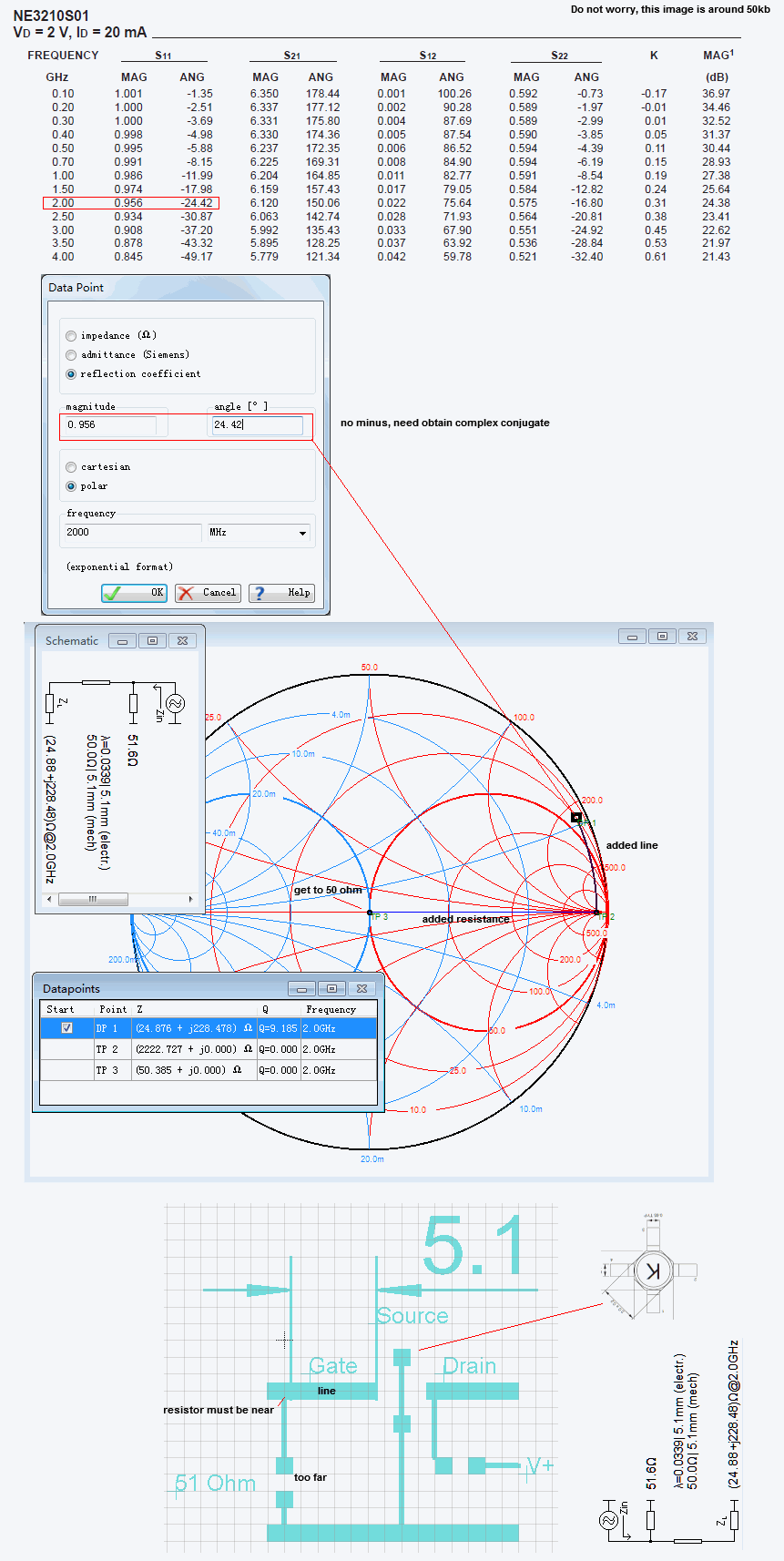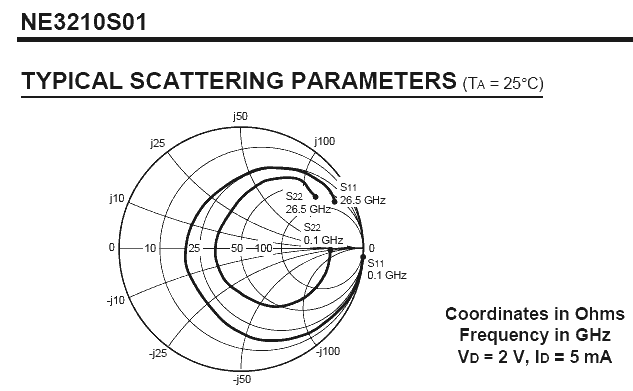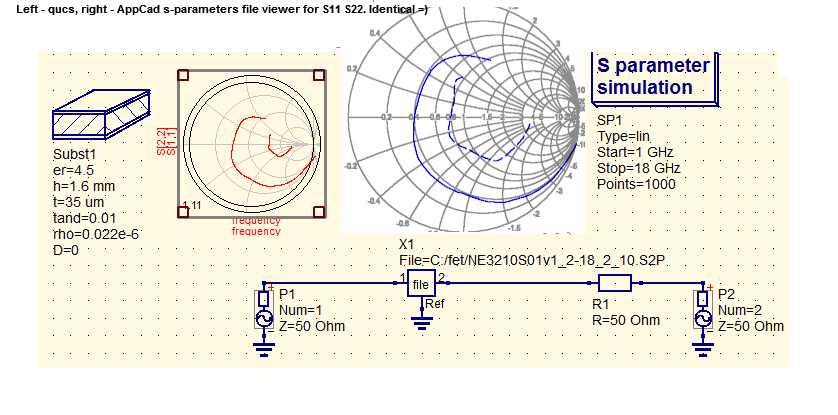Please check my Smith chart and PCB for matching NE3210S01 input to 50 Ohm at 2GHz.
Suppose we have NE3210S01 FET and trying to match it input to 50 Ohm on a hypothetical Er=1 substrate pcb. From my book and mostly from internet i learned that input and output impedance can be obtained from S-parameters (S11 and S22). I take S11 and use its complex conjugate to get rid of imaginary part to maximize power transfer. Here is design steps:

As i understand adding block and bypass capacitors (not put it here yet) must be analyzed with smith chart too.. What if i want to make frequency doubler, and put negative bias on gate, would it change anything? Just put negative voltage before 50 Ohm resistor?
Also some stupid question: how i know impedance of band-pass or hairpin microstrip filter?
Thanks.
well, what you have done is a good first step. But because S21 * S12 > 0, your input matching circuit effect the output match and vice versa. you have not taken that into account.
And what should i do next?
well, you need to enter the entire circuit into a modern analysis program and iterate the input and output match values together until they are good and broadband. There is a free one called QUCS that you can use.
Alternatively, you could build the thing and tune it on the bench until it is good enough.
Er=1 ... Does your circuit work on the air ?
I thought at first can use Er=1, and then correct traces lenghts for some material in the end, idea from tutorial on smith chart.
Going to download QUCS, nice screenshots. How far would be my results if i use separate matching of input and output using Smith Chart from results of modern simulation program? I hope i can learn QUCS quickly and see it myself.
you can be pretty far off, maybe losing 6 dB of gain. this is because without proper analysis you will probably have a narrowband match, and if a narrowband match moves off frequency, the gain will drop quickly.
you can be pretty far off, maybe losing 6 dB of gain. this is because without proper analysis you will probably have a narrowband match, and if a narrowband match moves off frequency, the gain will drop quickly.
Hello again!
I downloaded S-parameters files for NE3210S01 from this webpage: http://www.renesas.eu/products/micro...j_dp/index.jsp
My first confusion is why there are three sets of S-parameters?
NE3210S01v1_2-18_0_-2p5.S2P - Vds = 0 V Vgs = -2.5 V (device is turned off, but some negative DC bias on gate?)
NE3210S01v1_2-18_0_0.S2P - Vds = 0 V Vgs = 0 V (completly off, only AC input)
NE3210S01v1_2-18_2_10.S2P - ! Vds = 2 V Id = 10 mA <-- (i think need use this file, looks like typical safe biased operation). Is that right?
QUCS is very good program, although it is not so obvious how things can be done because need to add some equations. Fortunately i've found this tutorial: http://ocwitic.epsem.upc.edu/assigna...de-qucs-per-rf (A Qucs Tutorial for RF Transmission Lines) Very good tutorial.
Also i found information about using SPICE model of some transistor in QUCS: http://est3.lmn.pub.ro/Posted%20repo...ing_report.pdf. But i read somewhere that S-parameter files can be successfully used for many simulations, representing device as a "black box" with known input and output. So i decided stop searching for spice equivalent scheme of NE3210S01 and use simple S-parameters file NE3210S01v1_2-18_2_10.S2P.
After adding two-port S-parameters box to QUCS i found some unknown Vref voltage pin, and connected it to ground. Actually it is modified last example of line matching to 300 Ohm at http://ocwitic.epsem.upc.edu/assigna...de-qucs-per-rf tutorial. So here it is:

And build Smith-chart for it. My idea was that if i see smith chart of a raw device, it must be something like datasheet:

But it is not. Frequency sweep range the same as in datasheet (100Mhz to 26GHz)
I want to build a simple circuit with S-parameters box as a starting point for further matching. So what is wrong here? Should i add 50Ohm at the end or maybe decoupling capacitors. My QUCS schematic source files here: qucs-schematic.zip
Hello! I am happy to say that i found out how to see right S-parameters.
Here is comparansion of AppCAD view of S11 S22 parameters from S2P file and QUCS output for the same file:

So i guess i can start to add transmission lines, resistors, etc. at both sides of transistor "s-parameters box" and to make S11 and S22 graphs come to for example matched on both sides to 50 Ohm (center on Smith Chart) for some frequency range?
OR if i want to match input and output to some complex impedances, first find complex conjugates of them, put them on Smith chart and try some stubs and capacitors to move S11 S22 curves to that points at some frequencies?
good for you!
With all the billions of S governments give to universities, you would think that there would be a whole palette of free engineering software available out there. But when you look, other than SPICE, Sonnet lite, or QUCS, you are on your own shelling out outrageous amounts of money. I would really like to see a free software package of the ilk of HFSS!
is any one still here? i have a question about this post!
in which simulator do u plot the pcb?
do u have useful tutorial about smitchart and matching ?
i want to simulate attached picture and get the same result anyone knows what should i do? u see the problem is that dc biase is not the known biased which i have its s parameters as s2p file (i=10ma), so i think i should start from dc biase! am i right?
another problem is with negative biase of gate in pictures it seems that there is no negative voltage on gate ! is it possible or i am wrong
All pictures are made from screenshot pieces taken from various programs. I have used this programs:
1) AppCAD to view s-parameters and some other useful things
2) Smith v3.10 by Fritz Dellsperger to do matching
3) Qucs to do matching and compare with Smith v3.10 , but not much simulation
4) CadSoft Eagle to draw layout, no simulation, just plain PCB traces
Yes, from pictures gate bias is not negative.
I think you can get some acceptable results using QUCS, and s-parameters defined device (replacing transistor model, difficult to find for QUCS). You can start with adding simple s-parameters defined device with two ports and plot it s-parameters, then start adding some microstrip lines, etc.. (see QUCS screenshot in post #12)
I just use S-parameters given by manufacturer for negative bias, then put it in Smith v3.10 or Qucs. Put formulas from book to SpeqMath to calculate required S-parameters. Now doing more time with prototyping, rather than simulation.
